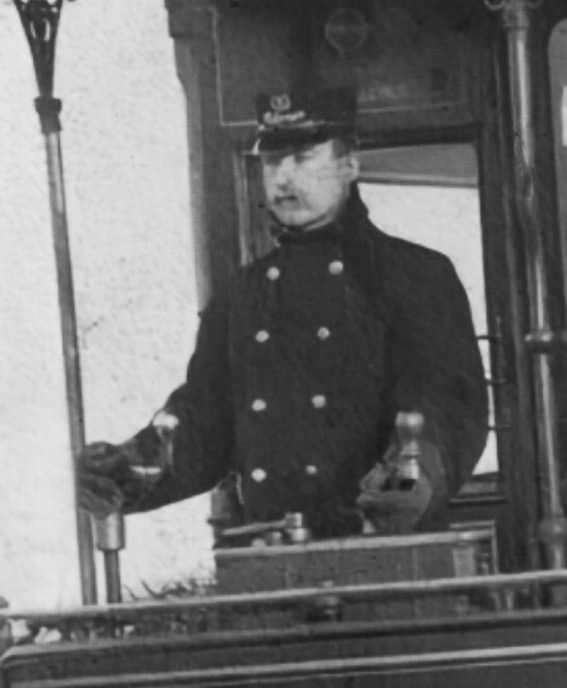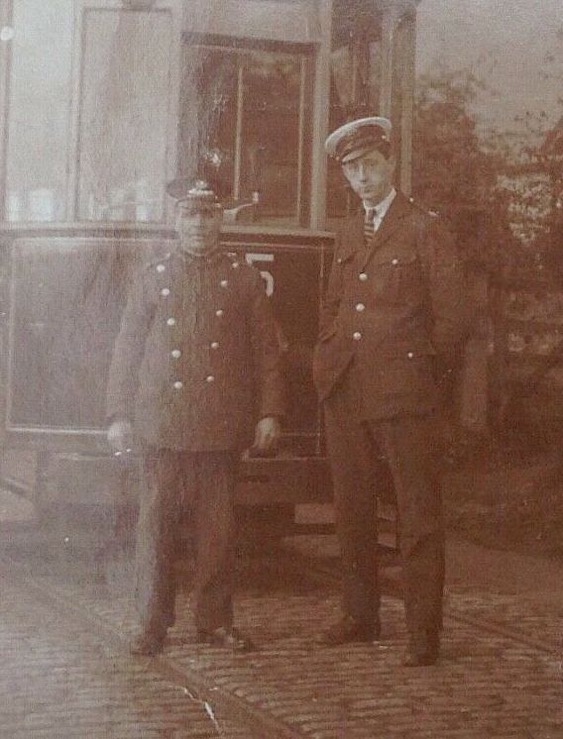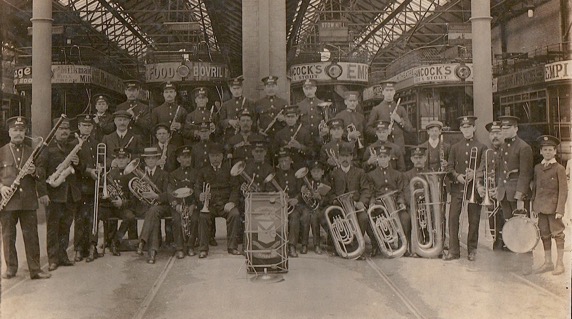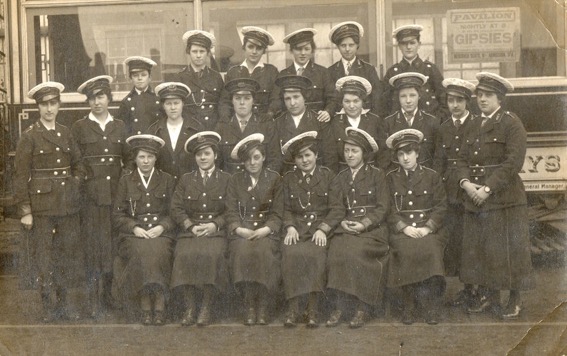Newport Corporation Tramways
History
Newport Corporation became a tramway owner on the 30th July 1894, when it took over of the existing, standard-gauge horse tramway of the Newport Tramways Company. However, the corporation, which had obtained powers to operate the tramway and was actively building extensions, chose not to operate the system itself, instead leasing it to Solomon Andrews and Son. The latter was acting on behalf of the South Wales Property, Machinery and Carriage Company Limited, a company which Solomon Andrews & Son owned. It seems likely, though not certain, that the operating assets (e.g., tramcars, horses, depot etc.) acquired from the NTCo were sold to the SWPM&CCo.
The corporation continued building extensions to the horse tramway until late 1901, the last — the Corporation Road route — being expressly constructed for eventual conversion to electric traction. This took the horse tramway to around 5.6 miles, comprising lines: southwards from Newport Bridge to Pill; northwards from Newport Bridge along Malpas Road to Prospect Street; northeastwards along Caerleon Road to Somerset Road, and along Church Road to Duckpool Road; eastwards along Chepstow Road to the Cross Hands Hotel; and southeastwards along Corporation Road to Spytty Road.
On the 30th July 1901, with Solomon Andrews & Son having made it clear that the company did not wish to operate the tramway beyond the end of the initial 7-year lease, the corporation took over operation itself. Conversion to electric traction commenced in 1902, the first electric service running on the 9th April 1903, and the last horse tram service on the 9th November 1903.
The tramway was never very profitable, not helped by steadfast opposition — from many quarters — to Sunday working, which basically saw the fleet lying unused (until 1922) for one day in every seven. Despite this under usage, the tramcars themselves were in poor shape by 1912, requiring significant investment, following which the system was immediately plunged into the Great War, emerging, like many others, in seriously run-down condition.
Although a small number of new tramcars arrived in late 1921 and early 1922, by the late 1920s, the corporation had made the decision to abandon its first tramway route (Malpas Road) in favour of buses, closure taking place on the 1st February 1928. This decision was precipitated by road widening, which would have involved the corporation in expensive track renewal, and appears to have been taken on that basis alone, rather than as part of a cohesive and formal tramway abandonment policy; it was, however, soon followed, on the 18th August 1930, by the Chepstow Road route.
The corporation had obtained powers to run buses in 1914, but it wasn't until 1924 that the first services were implemented, initially to parts of the town (and beyond) not served by the tramway. The name of the undertaking was changed to Newport Corporation Tramways and Omnibuses in 1924, to reflect the new mode of transport. Bus services continued to expand throughout the 1920s and the 1930s, but suffered heavy competition from unregulated operators.
By the mid 1930s, with the department suffering continuous losses on the trams (between 1927 and 1937, only a single year yielded a profit), as well as the buses, the council decided — on the 10th November 1936 — to abandon the remaining tramway routes. As a result of this decision, the name of the undertaking was changed once again — in January 1937 — to Newport Corporation Transport.
The last tramcar, No 51, operated the last service on the 5th September 1937.
At its greatest extent, Newport Corporation Tramways electric network extended to 8.55 miles, comprising lines: northwards along Malpas Road to Pant Road; northeastwards along Caerleon Road to just beyond St Julians Terrace; eastwards along Chepstow Road to just beyond Aberthaw Road; southeastwards along Corporation Road to Lysaghts; southwards along Commercial Road to Alexandra Dock Gates; and westwards up Stow Hill to Risca Road.
Uniforms
Newport became a horse tramway owner as early as 1894, but only operated the services itself from 1901 through to their withdrawal in 1903, some 27 months in total. During this latter period, staff working the horse cars wore informal attire (see link), the sole official insignia being a municipal licence badge; the corporation therefore simply continued the policy of the previous owners and lessees.
Somewhat surprisingly, staff working the new electric services were not issued with uniforms either, this being justified, at least retrospectively, by the manager's concerns opposite staff turnover. Waterproof overcoats and caps were, however, provided from around August 1903, the former being single-breasted with collars of a darker colour than the main coat, and the latter taking the form of a drooping-peak cap. The caps carried a script-lettering grade badge — either 'Motorman' or 'Conductor' — above which a municipal-device badge was worn, comprising the borough shield within a wreath.
The 1904 uniforms comprised single-breasted jackets with five buttons (bearing the system title and municipal device — see link) and stand-up collars; the latter carried system initials — 'N C T' — on the bearer's right-hand side (in individual metal letters) and an employee number (in individual metal numerals) on the left-hand side. The drooping-peak caps continued in use, but were at some point (probably in the mid-Edwardian era) superseded by tensioned-crown peaked caps; the cap insignia, however, remained unchanged. The uniform was apparently grey with red piping, and in all likelihood, the badges and buttons were nickel.
In 1912 the uniform was changed to blue with red piping, and to a lancer-style of tunic with five pairs of buttons (narrowing from top to bottom), piped epaulettes and high fold-over collars; the latter continued to bear the same insignia as the earlier jackets. The cap badges, however, were changed to a large oval cloth design comprising embroidered system initials ('N.C.T.') above the bearer's grade — 'CONDUCTOR' and either 'DRIVER' or 'MOTORMAN' (which is unclear)— in block capitals. The new cap badges appear not to have been universally welcomed, or at least not universally imposed, as several photographs exist that show individuals still wearing the old cap badges as late as 1922.
The uniform was changed one last time (in late 1922) to a much more modern-looking, single-breasted cut with five plated buttons, two hip-level and two breast pockets (both with button closures), epaulettes and lapels; the upper part of the latter (the collars) bore embroidered system initials. The epaulettes, jacket cuffs and trousers were all piped. Apart from the piping, the caps and cap insignia remained unchanged. The uniform buttons were changed to chrome in the mid 1930s, though still bearing the title 'County Borough of Newport Tramways'.
Tramcar crews were also provided with double-breasted greatcoats with five pairs of buttons and high, fold-over collars; the latter possibly bore embroidered system initials — 'N. C. T' — on both sides, though this cannot be stated with certainty.
Only a single photograph of a senior member of staff appears to have survived from the first 15 years of the system's life; this indicates that inspectors wore single-breasted jackets with hidden buttons (or more likely hook and eye fasteners) edged in a finer material than the main body of the jacket; the jacket's stand-up collars probably bore system initials — 'N C T' — on both sides in embroidered script lettering. The caps were of the drooping-peak type; they bore a brocade hat band, on which a grade badge — 'Inspector' — was mounted, though it is unclear whether this was metal or embroidered.
By 1920, and rather unusually, inspectors appear to have been wearing the same double-breasted lancer-style tunics as tramcar staff, though heavily embellished with elaborate chevrons (light in colour) on both sleeve cuffs, and with the system initials (on the collars) in elaborate script-lettering rather than block capitals. Their tensioned-crown peaked caps bore the same style of oval cloth badge as tramcar crews, but with the grade, 'INSPECTOR'. A photograph taken on the last day of tramway operation (see below) shows two senior uniformed staff, either inspectors or possibly a more senior grade such a Chief Inspector; this suggests that by this time (1937), senior staff were wearing the same basic style of uniform that tramcar staff wore from 1922 onwards, but with the cap heavily braided on the peak.
In common with the vast majority of UK tramway operators, Newport employed the services of female staff to replace male employees lost to the armed services. The first ladies were appointed in July 1916 as conductresses — apparently always referred to as 'Women Conductors' in Newport — and from 1917, a small number of motorwomen too. Unlike most operators, however, Newport continued to employ female tramcar staff well after the war had finished, only releasing the last of them in August 1921. These ladies were issued with stylish uniforms comprising: long piped skirts, tailored single-breasted jackets with five buttons, a waist belt (with two buttons), lapels and epaulettes (with button closures); the belts and the epaulettes were both piped, whilst the collars bore embroidered system initials: 'N.C.T'. Headgear initially appears to have taken the form of a dark felt bonnet, which bore a hat band with embroidered system initials, this time with an extra full stop: 'N.C.T.'. At some point, the hat was changed to a peaked style with a wide tensioned crown; the cap was heavily piped and bore the same large oval cloth cap badge that was used on male caps, containing system initials ('N.C.T.') above the bearer's grade ('CONDUCTOR').
Further reading
For a history of the Newport's tramways, see: 'Trams and Buses of Newport — 1845 to 1981' by D B Thomas and E A Thomas; The Starling Press Limited (1982).
Images
Motormen and conductors

A slightly out of focus photograph, but one which was taken in 1903, prior to the issue of uniforms. The vehicle (Tramcar No 18) is pictured in the upper part of High Street. Photo courtesy of the Tramways and Light Railway Society, with thanks to David Voice.
Tramcar No 17 and crew captured on a snowy day on the Caerleon Road route, possibly at the terminus just beyond St Justins Terrace — photo undated, but probably taken in 1904 or 1905. Author's Collection.
An enlargement of the above photograph showing the motorman, who is wearing a corporation-issued greatcoat and a drooping-peak cap. The latter bears a script-lettering 'Motorman' grade badge along with a municipal-device badge.
Standard, off-the-shelf, script-lettering grade badges of the type worn by NCT staff from around 1904 to 1912. It is currently unclear whether the NCT badges in this period were brass or nickel. Author's Collection.
Newport Corporation municipal-device cap badge — nickel — issued to tramwaymen from around 1904 to 1912, but certainly worn by many employees well beyond 1912. Author's Collection.
Another enlargement of the above photograph, this time showing the conductor. Whilst the subject's cap is clearly a corporation issue, the situation with respect to the greatcoat is less clear, as it has plain buttons.
A conductor and a motorman with Tramcar No 20 (a Milnes product) — photo undated, but probably taken in the mid-Edwardian era given that the distinctive dash numbers were changed towards the end of Edward VII's reign. Author's Collection.
An enlargement of the above photograph showing the conductor. His right-hand collar bears systems initials — 'N C T' — whilst his left-hand collar bears an employee number, '72'. His cap carries a script-lettering grade badge, above which is a municipal-device badge comprising the borough shield within a wreath. For some reason, the motorman's cap (not shown), only bears a script-lettering grade badge.
Tramcar No 32, pictured in Friars Road, St Woolas around 1907. The motorman is clearly wearing a single-breasted jacket and tensioned-crown peaked cap. Photo courtesy of the Tramways and Light Railway Society, with thanks to David Voice.
A motorman and another staff member stand in front of what is almost certainly Tramcar No 55, delivered from Hurst Nelson in 1922 — although undated, it seems likely that the photograph was taken when No 55 was new. The motorman still has the older lancer-style jacket, and a cap badge arrangement that was superseded in 1912.
The crew of Tramcar No 18 pictured at Carleon Road — photo undated, but almost certainly taken in the 1930s. Both men are wearing piped caps with a cloth cap badge bearing system initials and the grade. Photo courtesy of the Tramways and Light Railway Society, with thanks to David Voice.
An enlargement of the above photograph showing the conductor (J Ferris) and motorman (A Watts).
Newport Corporation Tramways cloth 'CONDUCTOR' cap badge, of the basic type worn from 1912 through to closure in 1937. This badge has no full stops, whereas some photographs show them with. Author's Collection.
Newport Corporation Tramways cloth 'DRIVER' cap badge. It is unclear whether motormen wore this badge or a 'MOTORMAN' version. This badge has no full stops, whereas some photographs show them with. Author's Collection.
Conductor I Williams and Motorman S Peebles stand with Tramcar No 31 at the Risca Road terminus in 1934. Photo possibly by Dr H A Whitcombe, courtesy of the Tramways and Light Railway Society, with thanks to David Voice.
Senior staff
Newport Tramways and Electricity Band pictured in the tramway depot — photo undated, but probably taken in the mid-Edwardian era. Two of the men are inspectors, second from the left, and second from the right on the back row. The original photograph is believed to be in the possession of Newport Transport Limited.
An enlargement of the above photograph showing the inspector on the back row. He is wearing a fairly standard 'tramway inspector' uniform, along with a drooping-peak cap.
A scene taken on the last evening of operation — 5th September 1937 — when No 51 departed Westgate Square at 11.00pm, bound for the depot. Photo courtesy of Ann Griffiths.
An enlargement of the above photograph showing two of the senior staff, possibly inspectors, or perhaps a more senior grade such as Chief Inspector. Both men have elaborate braiding on their caps.
Female staff
A studio portrait of a Newport Corporation Tramways conductress — photo undated, but more than likely taken around the time conductresses were first appointed (1916). Author's Collection.
An enlargement of the above photograph showing details of the uniform insignia. The hat takes the form of a bonnet, with a hat band bearing embroidered system initials: 'N. C. T.'.
A studio portrait of an unidentified Newport Corporation Tramways conductress with her ticket punch and cash bag — photo undated, but more than likely taken later on in the Great War, when a switch was made from the bonnets to wide-crown peaked caps. Author's Collection.
An enlargement of the above photograph showing details of the uniform. The collars bear embroidered 'N C T' initials, whilst the cap bears the same oval cap badge worn by the men, containing the system initials and the grade.
A group of 19 conductresses and two boys (possibly points boys or parcels boys) — photo undated, but certainly taken between 1916 and 1921. Author's Collection.
An enlargement of the above photograph showing three of the conductresses in their stylish uniforms, with piped belts, epaulettes and caps. The lady in the middle clearly had aspirations outside the world of municipal transport!
A charming photograph that illustrates the uniform worn during and after the Second Work War, but after the demise of the tramway (1937). Photo courtesy of the Stephen Howarth Collection.